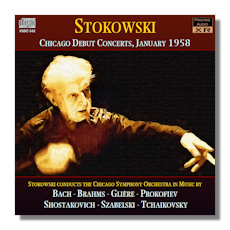
The Internet's Premier Classical Music Source
Related Links
-
J.S. Bach Reviews
Brahms Reviews
Gliere Reviews
Prokofieff Reviews
Shostakovich Reviews
Tchaikovsky Reviews - Latest Reviews
- More Reviews
-
By Composer
-
Collections
DVD & Blu-ray
Books
Concert Reviews
Articles/Interviews
Software
Audio
Search Amazon
Recommended Links
Site News
 CD Review
CD Review
Stokowski and the Chicago Symphony Orchestra

Debut Concerts, January 1958
- Johann Sebastian Bach:
- Nun komm, der Heiden Heiland, BWV 599
- Komm, susser Tod, BWV 478
- Mein Jesu! was vor Seelenweh, BWV 487
- Wir glauben all'en einen Gott, BWV 437
- Boleslaw Szabelski: Toccata
- Dmitri Shostakovich: Prelude "Zoya" (orch. Stokowski)
- Serge Prokofieff: Roméo & Juliet
- Piotr Ilyitch Tchaikovsky: Swan Lake Suite
- Johannes Brahms: Symphony #2
- Reinhold Gliere: Symphony #3 "Ilya Muromets"
Chicago Symphony Orchestra/Leopold Stokowski
Pristine Audio PASC242 2CDs
On 2 January 1958 Stokowski made his first appearance as a guest conductor with Fritz Reiner's Chicago Symphony. Reiner had been an assistant conductor under Stokowski in Philadelphia in the 30s. He had been with the Chicago Symphony for five years and already had brought it to international standards and made what came to be known as audiophile recordings, especially of Richard Strauss, for RCA. Stokowski quickly imbued the orchestra with his famous "Stokowski Sound" as can be heard in these recordings.
The concert on the second consisted of the Bach transcriptions, the Szabelski, Brahms' 2nd and the immolation music from Wagner's Götterdämmerung. He then repeated this music on the 3rd and in Milwaukee with the Chicago Symphony on the 6th. The Wagner was not included in this release because the music was taken from rebroadcasts where it was omitted. The present couplings are a bit frustrating because of the sound. The 2 January pieces sound much drier and shallow. This immediately apparent when you switch to the 9-10 concerts where the sound is fuller, richer and has better bass. That is, good to excellent. Of course the Szabelski is good to have in your Stokowski collection. The composer was Polish and lived from 1896 to 1979. The 1938 piece is neo-classical and opens with a jolly swinging, motoric beat reminding me of Prokofiev. While John Hunt's Stokowski book doesn't list this as a U.S. première I would not be surprised if it was. Once you switch to the Russian works the sound improves significantly. Of course neither the Prokofiev nor the Tchaikovsky are the traditional suites and bear the Stokowski stamp.
I listened to the second disc first and was initially disappointed in the sound on the Brahms. Repeated listenings adjusted my perception of the sound. I prefer his latter recording, from 1977 shortly before he passed, but this one is quite good and shows how quickly Stokowski got "his sound" from an orchestra. It should be noted that the first movement here is five minutes faster than the latter. The Gliere is simply a must-have and not just for Stokowski fans. The sound is excellent monaural with perspective and inner detail. The performance is amazingly intense. I thought it faster than his commercial stereo recording but in fact it is generally slower. The Chicago Symphony plays it with enthusiasm and I wouldn't be surprised if this was a Chicago Symphony première. You know, if you have been following Stokowski recordings that he heavily cuts the score. I've heard the uncut version. Stokowski was right.
Despite my few quibbles I can strongly recommend this release. We owe thanks to Pristine Classical and to Edward Johnson and John Kelly who supplied the original recordings (I am guessing from tapes but this is not stipulated in the notes).
Post Script: Stokowski's penultimate performance in Chicago included a 1966 performance of Shostakovich's 10th Symphony. This is a riveting interpretation in excellent sound and in the Leopold Stokowski Recording Library. People interested in having me make a copy can contact me at: rstumpfii@yahoo.com.
Copyright © 2011, Robert Stumpf II












